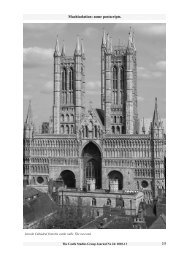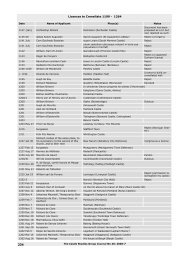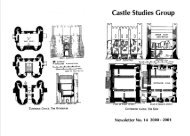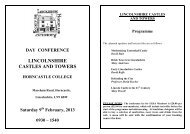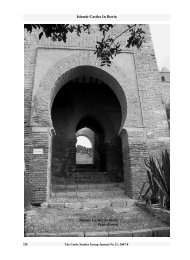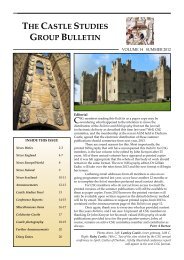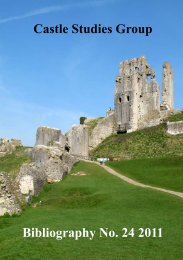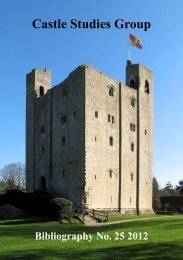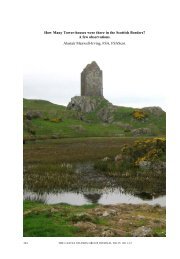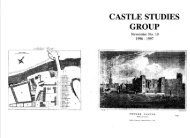Castle Studies Group Bibliography No. 22 2009
Castle Studies Group Bibliography No. 22 2009
Castle Studies Group Bibliography No. 22 2009
You also want an ePaper? Increase the reach of your titles
YUMPU automatically turns print PDFs into web optimized ePapers that Google loves.
As in all previous issues of this review-cum-bibliography, the views expressed here areentirely my own, and do not necessarily represent those of the <strong>Castle</strong> <strong>Studies</strong> <strong>Group</strong>,Amgueddfa Cymru – National Museum Wales, etc.The format remains as in previous issues, although I am aware that some publications underGeneral Articles could equally appear in the Regional/County Surveys section, and vice versa.Once more, readers will have to bear with my idiosyncrasies! I will continue to cover materialpublished on defences up to the Restoration of 1660 – i.e. I will include Henrician forts and theEnglish Civil War period etc. Information on important post-1660 material is being fed into theFortress Study <strong>Group</strong>’s Casemate.Part AGeneral MonographsThe following new books are examined, on the whole, in alphabetical order by author/editor.The first to consider is a recent title in Osprey’s Fortress series, number 82. This is MichaelBrown’s Scottish baronial castles 1250-1450, with illustrations by Adam Hook. It is in the usualformat, with plenty of colour photographs and drawings. It is a pity that we cannot get the CSGmentioned on the reverse of the title page in the same way that the Fortress Study <strong>Group</strong> ismentioned, CSG being more relevant to this volume that the FSG.One of a number of Boydell Press books considered this year is Stephen Bull’s ‘The furie ofthe Ordnance’, an examination of artillery during the seventeenth-century civil wars. The authoris Curator of Military History and Archaeology in Lancashire Museums. This is a most usefulstudy, and I draw the attention of readers to the fourth and fifth chapters in particular, onartillery fortifications and siege warfare respectively. Bull has been updated re his comment in<strong>No</strong>te 1 in Chapter 4, where he refers to my ‘good, though now dated’ bibliography of 1978, thefirst of the three CBA publications!A Cadw publication, not part of the usual guidebook sequence, is Nicola Coldstream’sBuilders & Decorators, examining medieval craftsmen in Wales. The author will be well knownto members through her paper on the role of Master James of St George in Edward I’s buildingcampaigns in Wales, and also through her 1994 book, The decorated style. Profusely illustrated,and to the usual high standard that we have come to expect from Cadw, the book covers thework of masons, sculptors, carpenters, tillers, painters and glaziers, and ends with a section oncraftspeople in Wales today. There are also eight box features, including one on James of StGeorge and another on building stone.I have the same problem this year as in previous – many of the best items to appear do sojust as I am about to prepare the bibliography, so in many cases there has been no time to readsuch publications thoroughly, not that one has much time anyway! A case in point is OliverCreighton’s Designs upon the land: elite landscapes of the Middle Ages. Ollie was one of thosewho gave a paper at the York conference in May, sharing the platform with Bob Higham andexamining the recent history of castle studies. Published by Boydell Press, this is far more thana book to do with castles, but covers a wide range of aspects concerned with ‘designedlandscapes’, an ‘in-phrase’ at the moment. It is a book that is a ‘must’ for any serious student ofcastle studies, among other things. The book is well produced, something that cannot be said ofall Boydell’s publications, with an excellent bibliography. It is not cheap, but then all Boydell’s2



